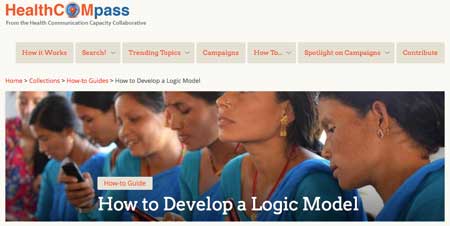Choosing Objectives
ABOUT THIS SECTION
Once a number of problem statements have been written, it is important to prioritize them and decide which communication and behavior objectives will bring about solutions to each. When doing so, keep in mind which behaviors are possible to monitor and whether or not the capacity to measure change exists. The development of a monitoring and evaluation plan should begin at this stage and not after.
Communication Objectives
Communication objectives clearly and concisely answer how a program will relate the need, benefit, and/or urgency of adopting a specific behavior. These short-term objectives measure drivers of behavior, such as knowledge, awareness, attitudes and social norms. While these factors influence the way people act, they are considered short-term outcomes because they do not measure actual behavior change.Behavior Objectives
Behavior objectives are descriptions of the actions a strategy intends to promote or change. These intermediate outcomes are behaviors that must happen in order to realize decreases in health outcomes like decreased morbidity and mortality.
Keep in mind that both communication and behavior objectives should be specific, measurable, achievable, realistic and time-sensitive (SMART) to ensure that it is appropriate and able to assess impact.
Developing strong communication and behavior objectives early in program planning ensures that a strategy’s outputs (e.g., activities, services or products) are capable of producing the outcomes (e.g., results or changes) that are needed. Determining short-term outcomes (e.g., MiP knowledge and attitudes) and intermediate outcomes (e.g., increases in pregnant women who receive IPTp) from the beginning is important because they will help guide the program and ensure that all stakeholders agree on and understand the program’s objectives prior to implementation. This is especially important for MiP, a health area with many donors, partners and program managers. One helpful way to imagine this pathway is through a logic model.
How-To Guide Step-by-step guidance on developing a logic model.
 The Roll Back Malaria SBCC Indicator Reference Guide shows how to measure levels of behavior change for malaria prevention and case management at the country level. Indicators from the document included below are those related to MiP. Exposure to messages, perception of risk, self-efficacy, response efficacy, and knowledge of malaria transmission a nd symptoms have been associated with preventive behaviors. The indicators in this guide are meant to be adapted to any priority audience (spouses, service providers, etc.). Examples of communication objectives included in the guide pertinent to MiP include:
The Roll Back Malaria SBCC Indicator Reference Guide shows how to measure levels of behavior change for malaria prevention and case management at the country level. Indicators from the document included below are those related to MiP. Exposure to messages, perception of risk, self-efficacy, response efficacy, and knowledge of malaria transmission a nd symptoms have been associated with preventive behaviors. The indicators in this guide are meant to be adapted to any priority audience (spouses, service providers, etc.). Examples of communication objectives included in the guide pertinent to MiP include:
- Proportion of pregnant women who recall hearing or seeing any malaria message within the last six months
- Proportion of pregnant women who perceive they are at risk from malaria
- Proportion of pregnant women who feel that the consequences of malaria are serious
- Proportion of pregnant women who believe the majority of their friends and family currently sleep under LLINs, take IPTp (if they are pregnant), and seek care for fever promptly
- Proportion of pregnant women who are confident in their ability to perform actions to prevent and control malaria in pregnancy
Use Likert Scale to assess confidence in ability to obtain LLINs, IPTp, or seek care for every promptly
- Proportion of pregnant women with a favorable opinion toward LLINs, IPTp, and ANC personnel (service providers)
Ask for opinions about LLINs, IPTp, ANC, and MiP service providers
- Proportion of pregnant women who believe that sleeping under LLINs, taking IPTp, and seeking prompt care for fever will reduce their risk
Ask about beliefs in LLINs, IPTp, and prompt care seeking
 The Roll Back Malaria SBCC Indicator Reference Guide provides examples of behavior objectives as well. Examples of behavior objectives included in the guide pertinent to MiP include:
The Roll Back Malaria SBCC Indicator Reference Guide provides examples of behavior objectives as well. Examples of behavior objectives included in the guide pertinent to MiP include:
Community indicators:
-
- Proportion of pregnant women that slept under an LLIN the previous night
- Proportion of women who received 3 or more doses of IPTp during ANC visits during their last pregnancy
- Proportion of women that attended at least one, two, and three ANC visits during last pregnancy
- Proportion of pregnant women who have encouraged friends or relatives to sleep under an LLIN, demand IPTp, or seek care for fever promptly
Ask if women have encouraged these behaviors, which behaviors they encouraged, who they encouraged or who encouraged them
Service provider indicators:
- Proportion of pregnant women at ANC that received IPTp according to national guidelines


